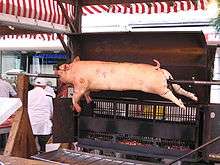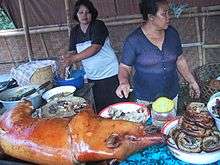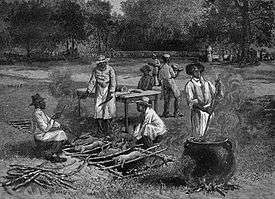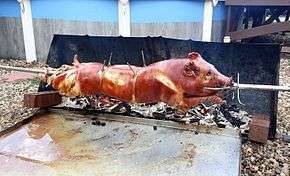Pig roast

.jpg)
A pig roast or hog roast is an event or gathering which involves the barbecuing of a whole hog (the castrated male pig or boar, bred for consumption at about 12 months old). Pig roasts in the mainland Deep South of the United States are often referred to as a pig pickin', although roasts are also a common occurrence in Puerto Rico and Cuba[1][2] as well as the non-mainland US state of Hawaii (a luau),[3] with roasts being done in the mainland states by descendants of other areas. A pig roast is traditional meal in Serbia and Montenegro, often prepared for celebration events and family fests, and it can be usually found on the menu of traditional taverns and bars - kafana.
Traditions

The tradition of the pig roast goes back millennia and is found in many cultures. There are numerous ways to roast pork, including open fire rotisserie style roasting, and "caja china" style box grilling.[4] Many families traditionally have a pig roast for Thanksgiving or Christmas. In Miami and other areas with large Cuban, Puerto Rican, Honduran or other Caribbean populations pig roasts are often held on Christmas Eve by families and friends[5][6] whereas families from Hawaii often hold a roast on memorial day.[3]
Pig roast (lechon asado) is a part of Puerto Rico's national dish and is usually served with arroz con gandules. In Puerto Rico, pig roasts occur year round, but happen in greater frequency as part of New Year's Eve celebrations and especially Christmas; occasionally if a family has relocated to the cities of the United States, they will take the recipe with them and use it during the summer.[7] In the Dominican Republic, "puerco a la puya" is a traditional part of the Christmas Eve meal.[8]
In the Philippines, the roasted pig is referred to as lechon baboy. It is traditionally prepared for Christmas celebrations but is also commonplace at birthday parties, weddings, debuts, and family reunions.[9]
In Indonesia, a pig roast is called babi guling, babi panggang or babi bakar; however it is rarely found in Indonesia, except in non-Muslim majority provinces, such as Hindu Bali and Christian Batak lands in North Sumatra, Minahasa people of North Sulawesi, Toraja in South Sulawesi, Papua, and also among Chinese Indonesians. In Bali, babi guling usually served with lawar and steamed rice; it is a popular dish in Balinese restaurants and warungs.[10] In Batak people's tradition, babi guling is a prerequisite in wedding offerings for the bride's family. In Papua, pigs and yams are roasted in heated stones placed in a hole dug in the ground and covered with leaves; this cooking method is called bakar batu (burning the stone), and it is an important cultural and social event among Papuan people.[11]
In various Chinese communities (especially in Southern China), a pig roast known as siu yuk is purchased for the sake of special family affairs, business openings, or as a ritualistic spiritual offering. For example, a tradition is to offer one or several whole roast pigs to the Jade Emperor to celebrate a Chinese film's opening with a roast pig; the pig is sacrificed to ward off evils in return to pray for the film's success. One garnish used to make the dish look more appealing is a circular slice of pineapple and cherry and is often placed in a red box for luck.
In the UK, the tradition of pig roasting, which is more commonly known in the UK as a Hog Roast, is popular on many occasions, particularly parties and celebrations. It is usually an outdoor event, and a staple meal on many show events.[12] The tradition is either to roast on a spit, turning the pig under a flame, or in a large oven in a roasting pan; roasting pigs around 130 lbs in weight is common in the UK. The pig is normally roasted in a gas propane machine. The pig's skin is scored with a sharp blade and covered in water & salt to make the 'crackling'. In ancient times going all the way back to the Saxons, roasting a wild boar was often the centerpiece of a meal at Yuletide, with Yule being Freya's fest. The head was often the greatest delicacy, as evidenced by the survival of The Boar's Head Carol.
In Spain, the locals call this a suckling pig or a "lechon asado". Hog roasts are becoming more popular across Spain and more so in Southern Spain due to the ex-pat community .

In the United States, roasting a whole pig or a feral hog has been a tradition for over two hundred years, especially in the Southern United States where it is closely linked to barbecue. From Virginia south to Florida Panhandle. and west to the Mississippi River south to Louisiana, the favored meat in Southern, Cajun, Appalachian, and Creole cooking is pork and has been since colonial times: pigs did not require any special handling or maintenance and could be sent off into the woods and rounded up again when supplies ran low, and thus were the prime choice for meat for small farmers and plantation owners, and for men living up in the mountains, the tradition was to drive their pigs to market every fall, fattening them up on the many nuts and acorns that proliferated in the area. George Washington even mentions attending a barbecue in his journal on August 4, 1769, [13] and records at Mount Vernon show the man had his own smokehouse on the premises. Like many plantation owners, he raised several pigs for slaughter in November and once his slaves had finished curing the meat into ham and bacon, they would pit roast some whole pigs over hot coals as a treat.[14] Outside of the English-speaking states of the South, francophone Cajuns, then as now, had cochon de lait as a traditional dish for the gathering of their large families.
Cooking

A hog/pig, often around 80-120 pounds dressed weight, is split in half and spread onto a large charcoal or propane[15] grill. The styles of grills used are as varied as the methods of producing them, some being homemade while others are custom made.
In a Hawaii-style pig roast, a large pit is typically dug into the ground and lined with banana leaves, as lava rocks are heated over an open flame until they are very hot. The heated rocks are placed into the pit, and a seasoned pig is placed inside and covered with additional banana leaves, which serve as insulation and for flavor.[16]
In an American Cuban-style pig roast, the "caja china" is the most commercially popular method by which to roast a whole pig.[17] In its more traditional form, a roasting box is commonly fashioned above ground out of concrete blocks and steel mesh.[18] Another popular method is to use a pig roasting box, the oldest and best known brand of which is "La Caja China."[19] The cooking process is communal and usually done by men; the host is helped by friends or family. It usually takes four to eight hours to cook the pig completely;[16][18] the pig is often started "meat-side" down, and then is flipped one time once the hog has stopped dripping rendered fat. When the cooking is complete, the meat should ideally be tender to the point of falling off of the bone. The meat is then either chopped or pulled or is picked off the roasted pig by the guests.
In the Philippines, the pig is typically stuffed with spices, placed on a bamboo spit, and roasted over hot coals.[20]
In Puerto Rico, pig roast is prepared in adobo mojado (wet seasoning) containing crushed garlic, black pepper, salt, orégano brujo, olive oil, and wine vinegar.
See also
References
- ↑ Cuban Pig Roasting Box
- ↑ How To Roast a Pig the Cuban Way
- 1 2 Pig Out! Mainland Luau
- ↑ "Caja China Style vs. Open Fire Pit Cooking « World Famous Caja China Style Cooking". Cajachinagrillmasters.wordpress.com. Retrieved 2012-08-05.
- ↑ Cuban Christmas Traditions
- ↑ In Miami, Christmas Eve Means Roast Pig
- ↑ Party With Pig: In Puerto Rico, a Glorious Feast
- ↑ "Puerco Asado Navideño Dominicano". Cocina Dominicana. Retrieved 2016-02-19.
- ↑ Menu: Lechon Baboy (Roast Pig)
- ↑ Babi guling Bali
- ↑ Bakar Batu Papua (in Indonesian)
- ↑ http://theroastofsherwood.co.uk/events/
- ↑ http://www.salon.com/2011/05/30/memorial_day_barbecue/
- ↑ http://afroculinaria.com/2013/01/24/hog-killing-time-comments-and-commentary-on-a-southern-plantation-tradition/
- ↑ Newport, NC Pig Cooking Contest Q and A
- 1 2 Traditional Kalua Pig Cooking in Hawaii
- ↑ "Caja China Style Cooking: Introduction to La Caja Asadora by Latin Touch". Shoplatintouch.com. Retrieved 2012-08-05.
- 1 2 The Best Way to Roast a Pig
- ↑ The La Caja China Box, In Cake and Real-Life Form
- ↑ BBQ - Philippine Style